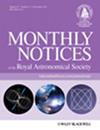强透镜子结构探测中的角度复杂性
IF 4.7
3区 物理与天体物理
Q1 ASTRONOMY & ASTROPHYSICS
引用次数: 0
摘要
强引力透镜可以用来发现原本不可见的暗物质亚haloes。在这种分析中,透镜星系质量模型是系统不确定性的一个重要来源。本文分析了透镜模型中角度复杂性的影响。我们使用多极扰动,在等密度等值线上引入与纯椭圆度不同的低阶偏差,同时保持径向密度曲线固定不变。我们发现,在类似于 HST 的数据中,与星系等密度中的多极扰动一致的多极扰动能非常有效地造成假阳性子结构探测。我们表明,这种退化的有效性取决于对纯椭圆的偏离程度和透镜配置。我们发现,当透镜模型中允许有百分之一的多极时,观测中可以探测到亚卤素的区域就会下降三倍。远离透镜图像的灵敏度大部分都丧失了。不过,在透镜图像上或其附近可探测到的物体的质量极限并没有改变。我们预计在透镜模型中加入多极扰动不会对强透镜约束暗物质模型的能力产生重大影响。不过,鉴于假阳性探测率很高,要使这类研究可靠,就应该把椭圆幂律以外的角度复杂性包括进来。我们讨论了对以往探测和未来工作的影响。本文章由计算机程序翻译,如有差异,请以英文原文为准。
Angular complexity in strong lens substructure detection
Strong gravitational lensing can be used to find otherwise invisible dark matter subhaloes. In such an analysis, the lens galaxy mass model is a significant source of systematic uncertainty. In this paper we analyse the effect of angular complexity in the lens model. We use multipole perturbations which introduce low-order deviations from pure ellipticity in the isodensity contours, keeping the radial density profile fixed. We find that, in HST-like data, multipole perturbations consistent with those seen in galaxy isophotes are very effective at causing false positive substructure detections. We show that the effectiveness of this degeneracy depends on the deviation from a pure ellipse and the lensing configuration. We find that, when multipoles of one per cent are allowed in the lens model, the area in the observation where a subhalo could be detected drops by a factor of three. Sensitivity away from the lensed images is mostly lost. However, the mass limit of detectable objects on or close to the lensed images does not change. We do not expect the addition of multipole perturbations to lens models to have a significant effect on the ability of strong lensing to constrain the underlying dark matter model. However, given the high rate of false positive detections, angular complexity beyond the elliptical power-law should be included for such studies to be reliable. We discuss implications for previous detections and future work.
求助全文
通过发布文献求助,成功后即可免费获取论文全文。
去求助
来源期刊

Monthly Notices of the Royal Astronomical Society
ASTRONOMY & ASTROPHYSICS-
CiteScore
9.10
自引率
37.50%
发文量
3198
审稿时长
3 months
期刊介绍:
Monthly Notices of the Royal Astronomical Society is one of the world''s leading primary research journals in astronomy and astrophysics, as well as one of the longest established. It publishes the results of original research in positional and dynamical astronomy, astrophysics, radio astronomy, cosmology, space research and the design of astronomical instruments.
 求助内容:
求助内容: 应助结果提醒方式:
应助结果提醒方式:


